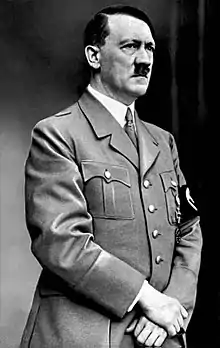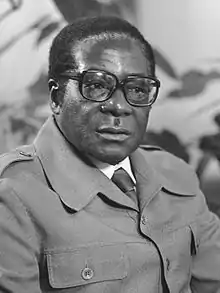Toothbrush moustache
The toothbrush moustache is a moustache style. The sides of the moustache are vertical (or nearly vertical) rather than tapered, giving the moustache hairs the appearance of toothbrush bristles that are attached to the nose. It was made famous by such comedians as Charlie Chaplin and Oliver Hardy. The style first became popular in the United States in the late 19th century—from there it spread to Germany and elsewhere—reaching a height of popularity in the inter-war years, before becoming unfashionable after World War II due to its association with German Nazi leader Adolf Hitler.
_1.jpg.webp)
Other names for this style of moustache include: the Hitler, Charlie Chaplin, 1/3 and philtrum moustache.
In the United States

The style originally became popular in the late 19th century in the United States.[1] It was a neat, uniform, low-maintenance style that echoed the standardization and uniformity brought on by industrialization, in contrast to the more flamboyant moustaches typical of the 19th century such as the Imperial, Walrus, Handlebar, Horseshoe, and Pencil.[1]
Charlie Chaplin was one of the most famous wearers of the toothbrush moustache, first adopting it in 1914 after his first film, "Making a Living", for his Mack Sennett silent comedies.[1] In a 1933 interview, Chaplin said he added the moustache to his costume because it had a comical appearance and was small enough so as not to hide his expression.[upper-alpha 1][2] Adolf Hitler was a fan of Chaplin films,[3] but "there is no evidence (though some speculation) that Hitler modeled his 'stache on [Charlie Chaplin]", according to cultural historian Ron Rosenbaum.[4] Chaplin took advantage of the noted similarity between his on-screen appearance and that of Hitler, such as in his 1940 film The Great Dictator, where he wore the moustache as part of two new characters that parodied Hitler.[1][5]
In Germany

The style was introduced in Germany in the late 19th century by visiting Americans.[1] Prior to the toothbrush, the most popular style was called the Kaiser moustache, perfumed and turned up at the ends, as worn by Wilhelm II, German Emperor.[1][5] By 1907 enough Germans were wearing the new trimmed down and simple toothbrush moustache to elicit notice by The New York Times under the headline "'TOOTHBRUSH' MUSTACHE; German Women Resent Its Usurpation of the 'Kaiserbart'".[1][6] The toothbrush was taken up by German automobile racer and folk hero Hans Koeppen in the famous 1908 New York to Paris Race, cementing its popularity among young gentry.[1][7] Koeppen was described as "Six-feet in height, slim, and athletic, with a toothbrush mustache characteristic of his class, he looks the ideal type of the young Prussian guardsman."[7] By the end of World War I even some of the German royals were sporting the toothbrush; Crown Prince Wilhelm can be seen with a toothbrush moustache in a 1918 photograph that shows him about to be sent into exile.[1]
Hitler originally wore the Kaiser moustache, as evidenced by photographs of him as a soldier during World War I.[8] There is no agreement as to what year Hitler first adopted the toothbrush.[1] Alexander Moritz Frey, who served with Hitler during World War I, said Hitler wore the toothbrush in the trenches after he was ordered to trim his moustache to facilitate the wearing of a gas mask.[1][9] Cultural historian Ron Rosenbaum instead says Hitler did not wear it until late 1919;[4] he was also photographed c.1921–1924[10] with a more traditional moustache in between wearing the Kaiser and toothbrush style.
Despite the photographic evidence of his much larger moustache during the First World War, Hitler's sister-in-law, Bridget Hitler, said she was responsible for giving Hitler his toothbrush moustache before the war[1]—considered by most scholars to be fiction designed to cash in on Hitler's notoriety.[11] Bridget claimed that Adolf spent a "lost winter" at her home in Liverpool in 1912–13.[1] The two quarreled a lot, mostly, she said, because she could not stand his unruly Kaiser moustache. He cut it, as she says in her memoirs, but that in doing so—as in most things—he went too far.[1][12]
Post-World War II

After World War II the style fell from favor in much of the world, due to its strong association with Hitler, and also became known as the "Hitler moustache".[1]
Artist Steve Ditko's original design for fictional character J. Jonah Jameson, a supporting character in the Spider-Man comics, sported a toothbrush moustache, apparently meant to make him seem Hitleresque and thus more loathsome, considering his extreme antagonism to Spider-Man, and most appearances of Jameson since his creation have maintained the style or a variant thereof in the comics. However, Jameson as portrayed by J. K. Simmons in the Sam Raimi Spider-Man film trilogy features a pencil moustache instead.
Ron Mael of the Los Angeles-based rock band Sparks maintained a toothbrush-moustache throughout most of the 1970s and 80s. Upon achieving mainstream success in the United Kingdom in 1974 with the song "This Town Ain't Big Enough for Both of Us", The Economist noted that "a whole generation switched on Top of the Pops, saw Ron Mael's moustache, and ran out of the room, crying, 'Mum! Dad! Hitler's playing the piano on 'Top of the Pops'!'"[13] (The Sparks song "Moustache" addresses the problem, with the lyrics "And when I trimmed it very small/My Jewish friends would never call.")
In 2009, British comedian Richard Herring, while sporting a toothbrush moustache, created a stand-up show titled Hitler Moustache, to see if he "could reclaim the toothbrush moustache for comedy—it was Chaplin's first, then Hitler ruined it."[14] The show also discusses broader issues, such as fascism and the British National Party.[5][15]
In May 2010, former basketball star Michael Jordan appeared in a Hanes commercial wearing a toothbrush moustache.[16] Reaction from the press and public was unfavourable.[17] Jordan's friend Charles Barkley said, "I have got to admit that I don't know what the hell he was thinking and I don't know what Hanes was thinking. I mean it is just stupid, it is just bad, plain and simple."[17] Jordan has not been seen with it since.
An extreme variant of the toothbrush moustache narrows it to the philtrum only; Robert Mugabe, for example (see image) wore this style.
Notable people with a toothbrush moustache
Notable people who groomed a toothbrush moustache during some time in their lives.
- Alexander Vasilyevich Alexandrov (image)
- Ivan Bagramyan (image)
- Siad Barre (image)
- Charlie Chaplin (image)
- Arthur Compton (image)
- Charles Culley (image)
- Karl Maria Demelhuber (image)
- Immanuvel Devendrar (image)
- Sepp Dietrich (image)
- Eliyahu Dobkin (image)
- Irmfried Eberl (image)
- August Eigruber (image)
- Levi Eshkol (image)
- Hermann Esser (image)
- Gottfried Feder (image)
- Max Fleischer (image)
- Francisco Franco [18]
- Naftaly Frenkel (image)
- Leonid Govorov (image)
- Oliver Hardy (image)
- Sadegh Hedayat (image)
- Heinrich Himmler (image)
- Adolf Hitler (image)
- Karl Holz (image)
- Paolo Iashvili (image)
- Michael Jordan [16]
- Vladimir Karpov [19]
- Friedrich Kellner (image)
- Erich Koch (image)
- Fumimaro Konoe (image)
- Semyon Krivoshein (image)
- Hinrich Lohse (image)
- Ron Mael (image)
- Clarence D. Martin (image)
- Emil Maurice (image)
- Davud Monshizadeh (image)
- Robert Mugabe (image)
- Julius Nyerere (image)
- Hermann Obrecht (image)
- George Orwell (image)
- Waldemar Pabst (image)
- Artur Phleps (image)
- Marcel Pilet-Golaz (image)
- Abdul Karim Qassem (image)
- Sayyid Qutb (image)
- Julius Raab (image)
- Ramakrishna Ranga Rao of Bobbili (image)
- Lothar Rendulic (image)
- Franz Ritter von Epp (image)
- Ernst Röhm (image)
- Mahmud Salman (image)
- Fritz Sauckel (image)
- Ferdinand Sauerbruch (image)
- Walter H. Schottky (image)
- Julius Schreck (image)
- Yitzhak Shamir (image)
- Jean Sibelius [20]
- Bakr Sidqi (image)
- Mehmed Spaho (image)
- Julius Streicher (image)
- Rafael Trujillo (image)
- Fred Trump (image)
- Christian Wirth (image)
- Genrikh Yagoda (image)
- Yisrael Yeshayahu (image)
- Yordan Yovkov (image)
- Georgy Zhukov (image)
See also
References
Notes
- In a 1933 interview, Chaplin said: "It all came about in an emergency. The cameraman said put on some funny make-up, and I hadn’t the slightest idea what to do. I went to the dress department and decided I wanted everything to be a mass of contradictions. So I took a bowler hat, an abnormally tight jacket, an abnormally loose pair of trousers, and some dirty, raggedy shoes. This was who I wanted my character to be; raggedy but, at the same time, a gentleman. I didn’t know how I was going to do the face, but it was going to be a sad, serious face. I wanted to hide that it was comic, so I took a little toothbrush mustache. And that mustache was no concept of the characterization – only saying that it was rather silly. It doesn’t hide my expression, after all, and is now my signature mustache."
Citations
- Rich Cohen (November 2007). "Becoming Adolf". Vanity Fair. Archived from the original on December 21, 2014 – via reprint in The Best American Essays 2008.
- Chaplin, Charlie; Hayes, Kevin (2005). Charlie Chaplin: Interviews. University Press of Mississippi. p. 15. ISBN 978-1578067022.
- Rochus Misch (2014). Hitler's Last Witness: The Memoirs of Hitler's Bodyguard. Frontline Books. p. 70.
Hitler loved Charlie Chaplin films
- Ron Rosenbaum (2000). The Secret Parts of Fortune: Three Decades of Intense Investigations and Edgy Enthusiasms. Random House. ISBN 978-0-375-50338-2.
- Tom Geoghegan (August 25, 2009). "Is wearing a 'Hitler' moustache a good idea?". BBC News Magazine. Retrieved January 1, 2020.
- "'TOOTHBRUSH' MUSTACHE.; German Women Resent Its Usurpation of the 'Kaiserbart'". The New York Times. October 20, 1907. Retrieved January 1, 2020.
- "Germany Awaits Lieut. Hans Koeppen; From Emperor to Subaltern His Running of the Protos Car Has Aroused Enthusiasm". The New York Times. July 18, 1908. Retrieved January 1, 2020.
- "The Rise of Hitler". The History Place. Retrieved January 1, 2020.
- Paterson, Tony (May 6, 2007). "Hitler was ordered to trim his moustache". The Daily Telegraph. Retrieved January 1, 2020.. This is not supported by any photographic evidence of Hitler during the period 1914-18.
- "Adolf Hitler In The Period 1890-1929". Avax News. Archived from the original on August 29, 2019.Alt URL. The top picture is his permission to carry weapons.
- Hamann, Brigitte (2010). Hitler's Vienna: A Portrait of the Tyrant As a Young Man. Tauris Parke Paperbacks. p. 198. ISBN 978-1848852778.
- Bridget Dowling (1979). My Brother-in-Law Adolf.. Written in 1930s and published posthumously in 1979.
- Jasper Rees (May 6, 2008). "Story of Their Lives: Sparks Will Fly". Intelligent Life. Archived from the original on December 11, 2014 – via The Economist.
- Richard Herring (July 31, 2009). "'There isn't a "New Offensiveness"'". The Guardian.
- Dave Gorman (July 29, 2009). "Writing wrongs... : Dave Gorman is angered by a 'dangerously bad' piece of journalism". Chortle.
- Michael Frissore. "Michael Jordan's Hitler Moustache". Slurve. Archived from the original on April 25, 2012.
- Trey Kerby (June 9, 2010). "Charles Barkley says what we're all thinking about MJ's mustache". Yahoo! Sports. Archived from the original on August 4, 2014. Retrieved August 3, 2014.
- Francisco Franco at dpa-newslab.com
- Vladimir Karpov at Commons
- Jean Sibelius at sibelius.fi
External links
 Media related to Toothbrush moustaches at Wikimedia Commons
Media related to Toothbrush moustaches at Wikimedia Commons